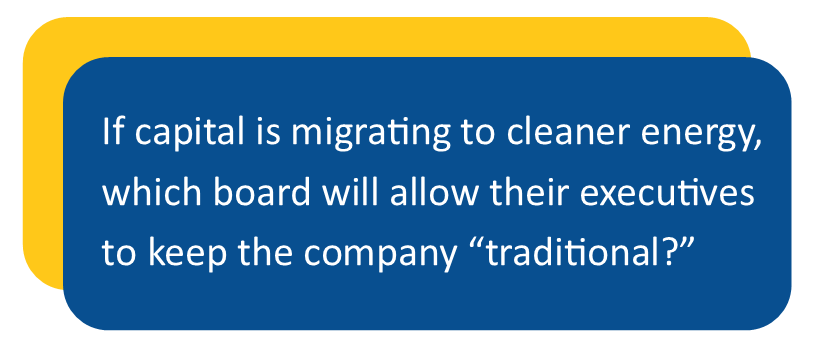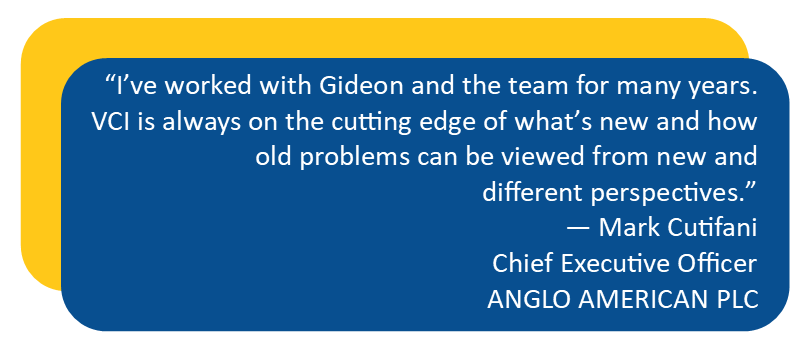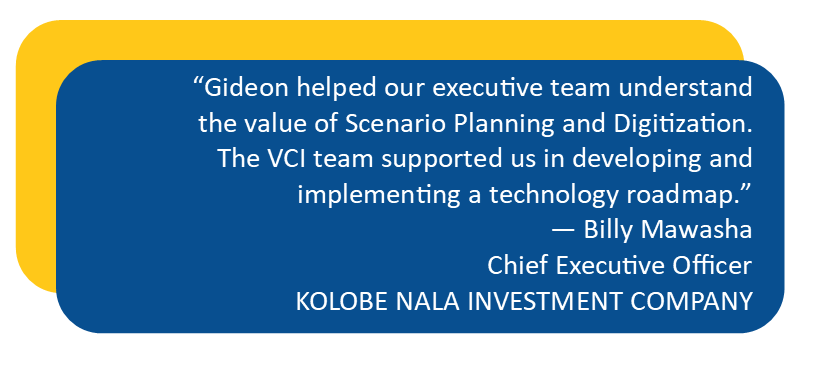By Gideon Malherbe
Founding Partner, Virtual Consulting
My view is that executives should focus on identifying their best plays using company-centric scenarios to jump ahead of the inevitable compliance-based, low margin, soggy center of a me-too ESG Report. Integrated climate assessment scenarios, the tools used today in climate policy research, were designed to support policy makers. However, these models require representing not only the energy system but also the climate system, the economy, land use, and all GHGs. The scope (national equilibrium) of these models does not serve corporate strategic planning well as a company is interested in selectively feeding into a future equilibrium system, not be the sole provider of that system.
By being pro-active and developing an internal scenario set, executives have a fantastic opportunity to not only redefine the company, but to deploy resources to aggressively generate revenue growth in this never-seen-before transition. The net present value of the climate transition is calculated at $1.7 trillion over the 2020–2050 period, using a 2% societal discount rate. Spending on incremental capital costs for low‐carbon, efficient, and electrified technologies ($980 billion in 2050) is offset by reduced spending on fossil fuels and incumbent technologies (−$835 billion in 2050).

The issue is deeper: A compliance-driven strategic approach will cause the company to be slower to market, as management waits for policy and regulations to guide them.
The consequence is that many of the potential community goodwill, offset agreements, land use and state/local incentives will have been absorbed by the front runners. Innovation as part of a company’s culture is also directly linked to those companies that take the lead in developing new and novel solutions. We know that “fast followers” consistently fail to successfully implement such innovations because their social contract is to wait for others to make things work.
Imagine we need carbon neutrality by mid‐century. Achieving this in only 30 years will be challenging, and pathways detailing the technologies, infrastructure, costs, and tradeoffs are needed. There are many pathways to achieve this with most scenarios forecasting U.S. energy needs at a net cost of 0.2–1.2% of GDP in 2050, which happens to be much less than estimated a few years ago.
All pathways lead to four basic strategies:
- Energy efficiency
- Decarbonized electricity
- Electrification
- Carbon capture
The actions required in all pathways are similar: expand renewable capacity 3.5-fold, retire coal, maintain existing gas generating capacity, and increase electric vehicle and heat pump sales to >50% of market share. It seems the more detailed the models go the more they reveal unexpected synergies, counterintuitive results, tradeoffs, and novel opportunities. And that is the point of the conversation. The best possible pathway to distinguishing breakthrough options is to develop an internal set of scenarios focused on the interrelationship between the company’s assets and sustainability opportunities and the commercial offset opportunities as a post facto target seeking exercise.
Let’s focus on reductions in energy and industrial CO2, which constitutes more than 80% of current gross greenhouse gas emissions in developed counties. We want to use realistic decarbonization options that reach net zero by 2050 while meeting demands for energy services at the lowest possible cost. The framework for developing your specific climate strategy should use the developed scenarios and then map the energy flows through the company, from primary energy inputs, such as petroleum and natural gas, to energy conversion processes, such as oil refining and power generation, to end uses.
Here the company scenarios differ widely from policy work: Whereas policy research seeks an optimized equilibrium state of demand and supply over future decades, corporate scenario planning looks at optimum transition options with the boundaries being the company assets. In other words, we question how the existing assets can be best leveraged to contribute to a cleaner future. Demand is not calculated as an equilibrium state but simply opportunities to produce a cleaner future. This is followed by seeking offset and financing opportunities. The company wants to discover what opportunities there are to invest in variable renewable energy (VRE), produce low‐carbon fuels from biomass and electricity, decarbonize challenging end uses in industry and freight transport, and possible incorporation of carbon capture, utilization, and storage (CCUS) into the overall asset base.
Retirement of gas-fired capacity remains ill-advised as hourly balancing in an expanded carbon neutral system, predominantly wind and photo voltaic generation remains cost competitive. On a low‐wind, high‐load day, significant gas generation will be required during every hour of the day. Batteries can economically time‐shift renewable generation from surplus to deficit periods over the course of a day. But batteries are not cost effective for long duration balancing. However, flexible consumer loads (e.g., EVs and water heaters) are also cost competitive with batteries in providing peak‐load reduction. Hard to electrify systems allows for the economic overbuilding of renewables to reduce the need for other balancing resources on energy‐constrained days, and thus increasing the competitiveness of VRE against other low‐carbon generation.
A company’s scenarios should look at the next 30 years, assuming nothing, in order to develop pathways the company may follow in answering the wicked question – how will we curb climate change? This narrative includes all references made above, but more critically looks at people and nations’ behavior dimensions, macro-economic forces including global trade and new-liberal economic ideologies. Most critical are the scenario stories that cover technology innovation, including Web3 / meta-verse potential futures. These scenario narratives then form the basis for solution seeking by fitting the ideas into the company’s existing asset base or potential additionally acquired assets because of the financial fit in a future scenario.
KEY TAKEAWAYS:
- Carbon neutrality is affordable
- Renewable electricity is the foundation of an affordable transition
- Recognizing tradeoffs between decarbonization strategies is essential
- The actions required in the next 10 years can be designed with high confidence
- Scenarios should drive the company strategy to sustain further optionality


Your participation enriches the conversation.
Click HERE to download this white paper
We are actively helping companies with their Scenario Planning so please feel free to reach out.

Gideon Malherbe is Founding Partner of Virtual Consulting (VCI) and well known for his development and implementation of unique methodologies and strategic insights that deliver truly extraordinary results for clients. As visionary of VCI, Gideon has orchestrated strategic positioning projects for clients worldwide. Over the past 20 years, he has helped hundreds of CEOs with their Scenario Planning projects.
Virtual Consulting USA, Inc.
New York, New York
+1 914-381-0000
gideon@virtualconsulting.com
February 2022 © Virtual Consulting USA, Inc.





